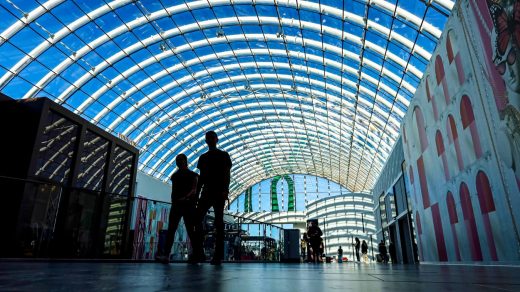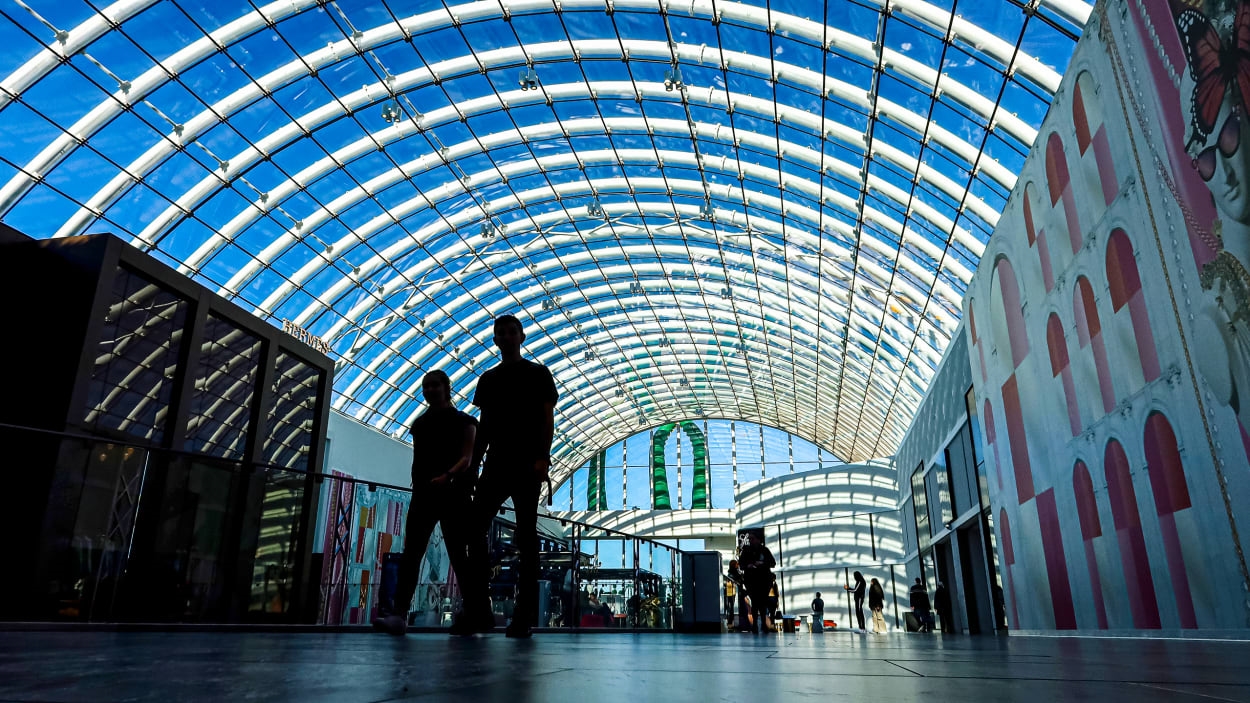The American Dream mall sets its sights beyond traditional retail
By Adam Bonislawski
Here’s a riddle for connoisseurs of the good life. You hit the slopes in the morning, take in a wine tasting over lunch, then spend the afternoon browsing Balenciaga shoes and Hermès scarves. Where are you? Aspen? St. Moritz? Gstaad?
How about East Rutherford, New Jersey?
We speak of the American Dream mall, Canadian conglomerate Triple Five Group’s endeavor to take retail to new heights of amenitization. Sprawling across roughly three million square feet seven miles from Manhattan, the development hosts a raft of high-end outlets, including shops from luxury brands like Gucci, Louis Vuitton, Tiffany, and Yves Saint Laurent. Perhaps more unique, it features entertainment options—a water park, a wave pool, an indoor ski slope, a Nickelodeon theme park—more typical of vacation destinations like Las Vegas or Orlando than a mall in the north Jersey suburbs.
But while American Dream is an extreme example, it’s also emblematic of a larger trend within the mall space. Gone are the days when flirting teenagers and power-walking seniors accounted for the bulk of malls’ extra-retail activity. Not every property has replaced their Sunglass Hut with a laser tag center, but malls are more and more looking beyond traditional retail to draw in customers.
“What malls and other large retail properties have done over the past five to ten years, is reinvent themselves to become shop, work, live environments,” says Mark Hunter, managing director of retail asset services, the Americas, at real estate firm CBRE. “You can go there and go to the doctor, go get a meal, go to the theater. They have really increased their dwell times.”
For many years, it looked like American Dream might never open its doors at all. Originally named Xanadu, the project was launched by developer the Mills Corporation in 2004. When Mills ran into financial difficulty several years later, investment firm Colony Capital took over the project. Then came the 2008 financial crisis, and construction came to a halt. The administration of then Governor Chris Christie looked into having the project demolished, but after learning it could cost up to $100 million, chose to find a new operator to finish the project instead. That operator was Triple Five, which took control of the property in 2011.
Triple Five is an experienced mall operator, counting the Mall of America and Canada’s West Edmonton Mall among its holdings. American Dream proved a slog, though. The project took nearly a decade amidst a series of lawsuits, construction delays, and a changing retail landscape that seemed each year to grow less favorable to malls. Finally, in October 2019, the first phase of the property opened. Six months later it was forced to close as the COVID-19 pandemic shut down businesses across the country.
It has not, in other words, been a smooth journey. In 2021, the mall lost around $60 million. In August of last year, Triple Five missed a deadline for an interest payment on bonds used to finance the complex.
Recent developments, though, suggest the mall might have turned a corner. In November, Triple Five negotiated a deal with lenders giving it an additional four years to pay back $1.7 billion in construction loans. Meanwhile, its occupancy rate is now up over 80 percent.
Retail consultant Soozan Baxter says she is optimistic regarding the development’s prospects, citing as a key factor its proximity to New York City. As for whether the mall’s entertainment options will drive retail business, Baxter says that is unclear, but she points to the Orlando market and its extensive lineup of malls and outlets as a potential model.
“You can’t help but make the connection that [Orlando] has four outstanding shopping centers in a very entertainment-driven town,” she says.
Baxter’s fellow retail consultant Kate Newlin is more skeptical.
“That people are going to go from Manhattan to New Jersey to shop Gucci is counterintuitive,” she says. “It’s a hard lift.”
The property’s rising occupancy rates are promising, Newlin says, but it remains unclear how successful those retailers will be.
One observer, who asked to remain anonymous to discuss the matter, says that Triple Five has offered some American Dream retailers significant tenant concessions—a common practice, particularly during tough economic times. These concessions have made their deals palatable despite mediocre sales numbers, this observer says. Triple Five did not reply to interview requests.
Newlin says she sees American Dream as a “learning lab” of sorts for malls looking to revamp their business models.
“Is where this really will have an impact is in [fostering] a radical reconsideration of shared spaces in the suburban landscape?” she says. “Is there something here that is exportable beyond the American Dream mall that could be a new revenue stream for mall real estate owners?”
CBRE’s Hunter says American Dream’s location in middle of the country’s most populous metro area makes it possible to offer entertainment options at a scale not feasible at other properties. He says, though, that he believes the basic concept is broadly replicable.
Hunter adds that while the connection between entertainment and retail sales isn’t necessarily straightforward, the former does help drive the latter.
“It’s just more eyeballs,” he says. “If you go to the theater or dinner, you may not shop at Lululemon or another apparel store, but you might say to yourself, ‘Okay, the next time I’m here, because I didn’t know it was there.’”
More generally, though, Hunter says that malls aren’t in nearly the dire shape prevailing narratives would suggest.
“Coming out of the pandemic, malls had some of the strongest sales of growth of any property type—15 to 20 percent sales growth, on average,” he says. “Certainly some malls have closed, some have repurposed, but in general, most malls have weathered the storm and are doing quite well.”
(28)



